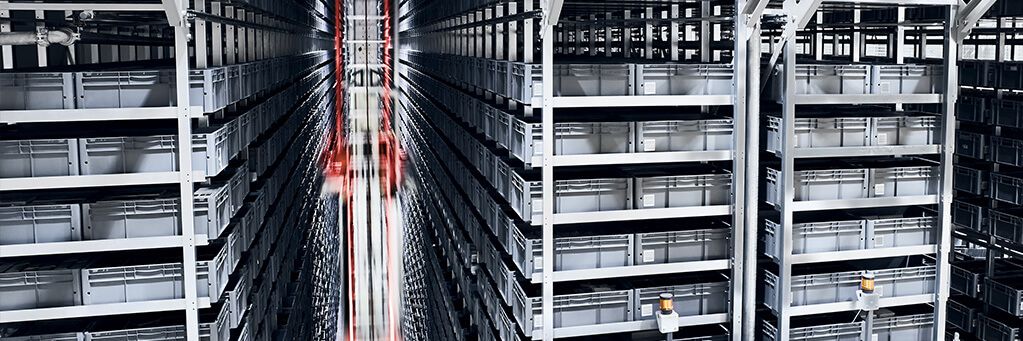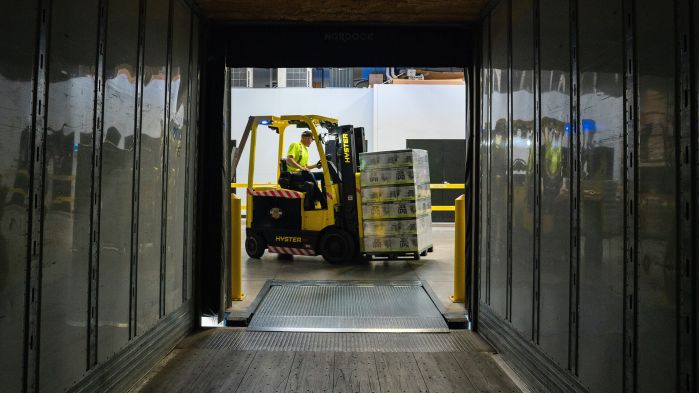“And now to the traffic: No traffic jams are expected on the main roads today. Despite the high volume of traffic, everything is running smoothly, and we do not anticipate any restrictions.” That sounds like good news! By the way, this is not only good news for commuters; it would also be great news for logistics companies. That’s because traffic jams can quickly build up as production volumes increase:
All unloading areas are full, pallets are piling up at the picking station, and employees are rushing around with forklifts but can hardly keep up with processing the delivery orders. Problems like this can be solved through warehouse automation. Read on to find out how this significantly increases efficiency, what automation solutions are available, and where the challenges lie.
Automation in logistics can mean many different things. The common denominator: technologies and systems are used to control the flow of goods as efficiently as possible and to make the best possible use of all resources (both machines and personnel).
Whether the warehouse is fully, semi or partially automated, there is a long list of advantages: First and foremost are the cost and time savings. Machines can perform tasks much faster and allow employees to take on more challenging tasks. Human error can also be minimised, partly because a machine operates day and night with the same level of performance. Fatigue is not a factor (at least as long as the power supply is adequate), which also increases employee safety: repetitive and sometimes dangerous tasks are particularly well suited to automation. In addition, robots and the like are more easily scalable and adapt to changing order volumes.
Warehouse automation relies on the following technologies:
- Conveyor technology: connects different production and storage areas
- Automatic storage and picking systems: to work as efficiently as possible, i.e. saving time, money and space
- Automated Guided Vehicle systems (AGVs): to transport goods from A to B within the warehouse without anyone manually controlling the process
- Robotics: can pack, pick and palletise, thus replacing manual labour
- AI and intelligent software: creates forecasts, assists in decision-making and optimises processes in general
From manual storage to partial automation of transport processes to automated warehouse systems – there are various stages on the path to full automation. Complete automation does not make sense for every company, which is why it is worth relying on an experienced IT service provider who can advise on the optimal degree of automation.
For smaller companies, the use of smart software can significantly reduce the workload, for example by designing intelligent workstations that use image processing systems to assist with order picking and quality control of individual parts. Although the degree of automation here is 0 percent, employees can work much faster and with fewer errors than without the smart software.
In fully automated warehouses, on the other hand, picking robots, inventory drones, AGVs and warehouse shuttle systems such as Autostore work hand in hand with human staff. A comprehensive software solution ensures that the individual processes are interconnected, thus ensuring smooth operation. This requires a detailed analysis of all collected data. It can be used to derive information about maintenance or individual steps that are not yet optimally integrated, for example. This is where the experience of the IT service provider comes into play.
It gets really interesting when it comes to combining manual and automated processes. The challenge: machines aren't flexible, so employees have to stick to workflows exactly.
The first step towards warehouse automation is usually taken with Autonomous Mobile Robots (AMRs) or AGVs, which take over defined transport processes. This allows staff to concentrate on more important tasks than moving pallets from one place to another. To make this work, employees must place the pallet at the defined source location and log it correctly in the system. Otherwise, the AGV, which then transports the pallet to the designated unloading area, cannot detect that there is something to do. One of the challenges is therefore that employees must strictly adhere to specified processes.
This is how an AGV-supported process could work:
- An employee places the prepared pallet on the defined source location. Important: The pallet must be booked exactly according to the workflow so that a message is triggered to the AGV.
- The warehouse management system (WMS) sends a transport order to the AGV. It moves to the specified location and picks up the pallet.
- The AGV drives through the hall with the pallet – thanks to its sensors, it moves at a safe distance from personnel and does not bump into anything.
- The AGV unloads the pallet at the predefined destination, for example the label chute. If there is no space there at the moment, there is an alternative destination stored in the system. The warehouse management system automatically records where the pallet is currently located.
- An employee can collect the pallet from the label chute and take it to the goods issue area.
The real art lies in connecting all the components. In logistics, the linchpin for this is the warehouse management system. All orders and processes carried out throughout the warehouse by various people, transport systems or other devices are controlled from there.
Let’s take transport orders as an example. During implementation, the warehouse management system is programmed to specify which locations are accessed by employees with forklifts and which by AGVs. Fixed logic can also be incorporated here: if the designated loading location is currently occupied, for example, the AGV knows to take the pallet to a defined alternative location and then execute the next transport order. Priorities can also be set this way.
The systems used for automation already provide important components: sensors for safe driving in the warehouse, control of warehouse shuttle systems, which decide which box is taken for storage during order picking and which shuttle takes the box to the port, and so on. The major task for IT service providers is to integrate these intralogistics solutions into the WMS and manage the individual processes so that everything meshes perfectly. This requires a great deal of experience.
Then, before the solution is introduced, it is time for a practical test: does the plan only work in theory or also in reality? Sometimes a problem is not technical in nature, but due to other circumstances in the warehouse.
For example, if an AMR needs QR codes on the floor to navigate, this is a nice method in theory, but unfortunately very impractical in practice. After forklifts have driven over the codes for a while, the adhesive no longer holds and the label comes off. Without the QR code, however, the robot no longer knows where to go. Test phases (and detailed discussion of possible scenarios) are therefore essential to ensure that automation ultimately brings the desired success.
The be-all and end-all of warehouse automation: talk, talk, talk! Close communication between IT service providers and companies is essential. In addition, a company must know its own processes as detailed as possible. The question it should always ask itself is: What do I want to achieve with automation?
In general, processes should meet a few basic conditions to be suitable for automation. Repetitive tasks that follow a fixed pattern are ideal for this. If a warehouse does not operate continuously, it is questionable whether investing in an automation solution is worthwhile: if the machines stand still every night, the process may not be profitable. In addition, all the necessary data on the individual processes must be available over a longer period of time in order to be able to estimate how profitable automation would be and exactly which steps need to be mapped.



